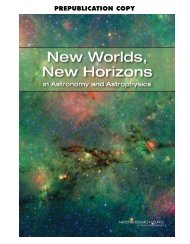Masao Sako (Penn)
Masao Sako (Penn)
Masao Sako (Penn)
You also want an ePaper? Increase the reach of your titles
YUMPU automatically turns print PDFs into web optimized ePapers that Google loves.
Host Galaxy Follow Up‣ Spectroscopy of SNcandidate host galaxies‣ 10000+ targets from DES SN‣ DES main survey - will the lightcurves be useful?‣ host redshifts, SFR, gas-phasemetallicity (S/N~10).No. 1, 2005SNe Ia HOST GALAXIESGallagheret al.(2005)‣ stellar population age, metallicities(S/N~50).‣ reduce Hubble scatter.‣ 5 - 10% contamination from non-Ia.‣ cannot identify spectroscopicallypeculiar types.Fig. 7.—Decline rate vs. host galaxy absolute magnitude. The distributionFig. 8.—Absolute magnithost galaxy samples. The hisstatistically brighter than ththeoretical SNe Ia distributio666 HOWELL ET AL.stretch1.3shows an absence of dimmer SNe Ia in the low-luminosity host galaxy regime.Therefore, H00 argued t1.2Type Ia supernovae delay time, or the time between progenitor cline rate and absolute 1.0 mformation and the SN event. Our simple model is in good agreementwith an average Type Ia supernova delay time of around absolute B magnitude ofrelation between decline1.13Gyr.Although Figure 7 doesNext, we set out to determine the expected effects that the H00, the plot does 0.8 showprogenitor age has on Type Ia supernova decline rate by first ap-a linear fit to the plot of core mass versus main-lection effect brought aaxies, Howell likely due to et a co1.0proximatingsequence mass from Dominguez et al. (1999) and converting our galaxies. al. (2009) Such an effectprimary masses into WD masses. Umeda et al. (1999) postulated from low-luminosity0.6ga0.9that the M 56 Ni,andconsequentlythebrightnessoftheSNIa,increasesas the C/O ratio of the progenitor increases. Based on according to Figure 1, fin the low-luminosity gthe postulate, they developed a model describing this dependency.Although the model should be treated with caution, given axies. Therefore, we seeelliptical galaxies, 0.4 whic0.8that it is based on an unproven postulate, we use it in our toy be hosted by large, brigh0.7model merely to provide a rough understanding on the effects of effects contributes to theage on the decline rates of SNe Ia. Therefore, using these 56 Ni Figure 8 shows 0.27 8 9 10 11 12the hiyields and the M 56 Ni to mLog 15 (B) (Host relationsdescribedinx Mass)3.2.1, galaxy distributions. Th 7.Ni Mass
















